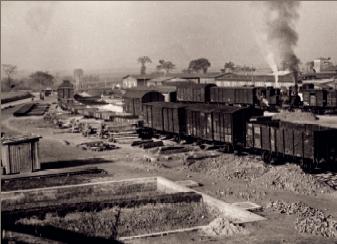Arrival
The Transports
On the transports to the camps, the prisoners were penned up inside freight wagons, sometimes for days, with no privacy and nowhere to sleep. They even had to relieve themselves in front of others. In the summer heat or winter cold, conditions inside the wagons were especially unbearable. There was no water and sometimes no food. These conditions resulted in disease, injuries and death. Prisoners who tried to escape were shot. Smaller groups or individual prisoners were transported in police vehicles and sometimes in the passenger carriages of trains. The transports arrived at the railway stations in Bergedorf or Curslack. From there, the prisoners were marched to the camp. A connecting railway line was completed in the winter 1943/44, enabling the trains to run directly to Neuengamme camp.
The “railway station” at Neuengamme concentration camp in 1944. The connecting tracks were laid in 1943/44. The rails branched off from the Bergedorf-Geesthacht railway line between Bergedorf and Zollenspieker at the Elbe. From spring 1944, the goods wagons were used to transport prisoners as well as goods.
